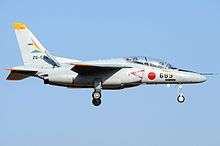Japan Air Self-Defense Force
| Japan Air Self-Defense Force | |
|---|---|
| 航空自衛隊 | |
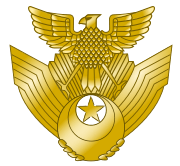 Japan Air Self-Defense Force emblem | |
| Founded | 1 July 1954[1] |
| Country |
|
| Type | Air force |
| Role | Aerial warfare |
| Size |
50,324 personnel (2013)[2] 777 aircraft |
| Part of |
|
| Garrison/HQ | Ichigaya, Shinjuku, Tokyo, Japan |
| Motto(s) | "Key to Defense, Ready Anytime!" |
| Website |
www |
| Commanders | |
| Commander-in-Chief | PM Shinzō Abe |
| Minister of Defense | Takeshi Iwaya |
| Chief of Staff, Joint Staff | Admiral Katsutoshi Kawano |
| Chief of the Air Staff | General Yoshinari Marumo |
| Insignia | |
| Roundel |
  |
| Ensign |
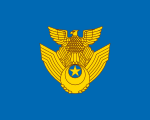 |
| Aircraft flown | |
| Attack | F-2, F-35A, F-4EJ |
| Electronic warfare | E-767, EC-1, E-2C, EC-2 |
| Fighter | F-4EJ, F-15J/DJ, F-2, F-35A |
| Helicopter | UH-60J, CH-47J |
| Interceptor | F-15J |
| Trainer | F-15DJ, T-7, T-400, T-4 |
| Transport | C-1, C-2, KC-767J, C-130H, Boeing 747-400 |
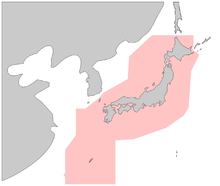
The Japan Air Self-Defense Force (航空自衛隊 Kōkū Jieitai), JASDF, also referred to as the Japanese Air Force,[3] is the air warfare branch of the Japan Self-Defense Forces, responsible for the defense of Japanese airspace and for other aerospace operations.[4] It is the de facto air force of Japan. The JASDF carries out combat air patrols around Japan, while also maintaining a network of ground and air early-warning radar systems. The branch also has an aerobatic team known as Blue Impulse and has provided air transport in UN peacekeeping missions.
The JASDF had an estimated 50,324 personnel as of 2013, and as of 2013 operated 777 aircraft, approximately 373 of them fighter aircraft.[5]
History
Japan did not have a separate air force before World War II. Aviation operations were carried out by the Imperial Japanese Army Air Service and the Imperial Japanese Navy Air Service (Kōkūtai). Following World War II, the Imperial Japanese Army and Navy were dissolved and later replaced by the JSDF with the passing of the 1954 Self-Defense Forces Law, with the JASDF as the aviation branch.
Until 2015, women were banned from becoming fighter jet and reconnaissance aircraft pilots, with the first female pilot of a F-15s set to join the ranks, along with three other female pilots currently in training, in 2018.[6]
Organization

Major units of the JASDF are the Air Defense Command, Air Support Command, Air Training Command, Air Development and Test Command, and Air Materiel Command. The Air Support Command is responsible for direct support of operational forces in rescue, transportation, control, weather monitoring and inspection. The Air Training Command is responsible for basic flying and technical training. The Air Development and Test Command, in addition to overseeing equipment research and development, is also responsible for research and development in such areas as flight medicine.
The Air Defense Command has northern, central, and western regional headquarters located at Misawa, Iruma, and Kasuga, respectively and the Southwestern Composite Air Division based at Naha, Okinawa Prefecture. All four regional headquarters control surface-to-air missile units of both the JASDF and the JGSDF located in their respective areas.
_at_RIAT_Fairford_17July2017_arp.jpg)
- Prime Minister of Japan
- Minister of Defense
- JASDF Chief of Staff / Air Staff Office
- Air Defense Command: Yokota, Fussa, Tokyo
- Northern Air Defense Force: Misawa, Aomori
- 2nd Air Wing (Chitose Air Base: 201SQ, F-15J/DJ, T-4; 203SQ, F-15J/DJ, T-4)
- 3rd Air Wing (Misawa Air Base: 3SQ, F-2A/B T-4)
- Northern Air Command Support Flight, (Misawa, T-4)
- Northern Aircraft Control & Warning Wing
- 3rd Air Defense Missile Group
- 6th Air Defense Missile Group
- Central Air Defense Force: Iruma, Saitama
- 6th Air Wing (Komatsu Air Base: 303SQ, F-15J/DJ, T-4; 306SQ, F-15J/DJ, T-4)
- 7th Air Wing (Hyakuri Air Base: 301SQ, F-4EJ-Kai, T-4; 302SQ, F-4EJ-Kai, T-4)
- Central Air Command Support Squadron (Iruma Air Base T-4, U-4)
- Central Aircraft Control & Warning Wing
- 1st Air Defense Missile Group
- 4th Air Defense Missile Group
- Iwo Jima Air Base Group
- Western Air Defense Force: Kasuga, Fukuoka
- 5th Air Wing (Nyutabaru Air Base: 305SQ, F-15J/DJ, T-4)
- 8th Air Wing (Tsuiki Air Base: 6SQ, F-2A/B, T-4; 8SQ, F-2A/B, T-4)
- Western Air Command Support Squadron, (Kasuga, T-4)
- Western Aircraft Control & Warning Wing
- 2nd Air Defense Missile Group
- Southwestern Air Division: Naha, Okinawa
- 9th Air Wing (Naha Air Base: 204SQ, F-15J/DJ, T-4; 304SQ, F-15J/DJ, T-4
- Southwestern Air Command Support Squadron, T-4)
- Southwestern Aircraft Control & Warning Group
- 5th Air Defense Missile Group
- Airborne Early Warning Group: Hamamatsu Air Base (602SQ, E-767)
- Tactical Reconnaissance Group: Hyakuri Air Base (501SQ, RF-4E, RF-4EJ)
- Air Tactics Development Wing (Yokota Air Base)
- Tactical Fighter Training Group: Komatsu Air Base (F-15DJ/J, T-4)
- Electronic Warfare Squadron Iruma Air Base (EC-1, YS-11EB)
- Electronic Intelligence Squadron Iruma Air Base (YS-11EB)
- Air Rescue Wing
- Air Defense Missile Training Group: Hamamatsu, Chitose
- Northern Air Defense Force: Misawa, Aomori
- Air Defense Command: Yokota, Fussa, Tokyo
- Air Support Command: Fuchū Air Base, Tokyo
- 1st Tactical Airlift Group (Komaki Air Base: 401SQ, C-130H, KC-130H; 404SQ, KC-767J)
- 2nd Tactical Airlift Group (Iruma Air Base: 402SQ, C-1, U-4)
- 3rd Tactical Airlift Group (Miho Air Base: 403SQ, C-1, C-2; 41SQ, T-400)
- Air Traffic Control Service Group
- Air Weather Group
- Flight Check Squadron (Iruma Air Base: U-125,YS-11FC)
- Special Airlift Group: (701SQ Chitose Air Base: B747-47C as Japanese Air Force One)
- Air Training Command: Hamamatsu, Shizuoka
- 1st Air Wing (Hamamatsu Air Base: 31SQ, T-4; 32SQ, T-4)
- 4th Air Wing (Matsushima Air Field: F-2B; 11SQ, T-4 Blue Impulse 21SQ)
- 11th Flying Training Wing (Shizuhama Air Base: 1SQ, T-7; 2SQ, T-7)
- 12th Flight Training Wing (Hofu kita Air Base: 1SQ, T-7; 2SQ, T-7)
- 13th Flight Training Wing (Ashiya Air Base: 1SQ, T-4; 2SQ, T-4)
- Fighter Training Group (Nyutabaru Air Base: 23SQ (Ex-202SQ), F-15DJ, T-4)
- 1st, 2nd, 3rd, 4th & 5th Technical School
- Air Basic Training Wing
- Air Training Aids Group
- Air Officer Candidate School
- Air Development and Test Command: Iruma Air Base, Saitama
- Air Development and Test Wing (Gifu Air Base: F-15J/DJ, F-2A/B, C-1FTB, C-2, F-4EJ, F-4EJ-kai, T-7, T-4)
- Electronics Development and Test Group
- Aeromedical Laboratory
- Air Material Command: Jujou, Tokyo
- 1st, 2nd, 3rd & 4th Air Depot
- Air Staff College
- Air Communications and Systems Wing
- Aerosafety Service Group
- Central Air Base Group
- Others
- JASDF Chief of Staff / Air Staff Office
- Minister of Defense
Ranks
Officers(幹部)
| Insignia | General 統合幕僚長 および 航空幕僚長 たる空将 | Lieutenant General 空将 | Major General 空将補 |
Colonel 1等空佐 | Lieutenant Colonel 2等空佐 | Major 3等空佐 |
Captain 1等空尉 | First Lieutenant 2等空尉 | Second Lieutenant 3等空尉 |
|---|---|---|---|---|---|---|---|---|---|
| Type A (甲階級章) |
.svg.png) | .svg.png) | .svg.png) |
.svg.png) | .svg.png) | .svg.png) |
.svg.png) | .svg.png) | .svg.png) |
| Type B (乙階級章) |
.svg.png) | .svg.png) | .svg.png) |
.svg.png) | .svg.png) | .svg.png) |
.svg.png) | .svg.png) | .svg.png) |
| Miniature (略章) |
.svg.png) | .svg.png) | .svg.png) |
.svg.png) | .svg.png) | .svg.png) |
.svg.png) | .svg.png) | .svg.png) |
Warrant Officer and Enlisted(准尉および曹士)
| Insignia | Warrant Officer 准空尉 | Senior Master Sergeant 空曹長 | Master Sergeant 1等空曹 | Technical Sergeant 2等空曹 | Staff Sergeant 3等空曹 | Airman 1st Class 空士長 | Airman 2nd Class 1等空士 | Airman 3rd Class 2等空士 | OR-D Self Defence Official Cadet 自衛官候補生 |
|---|---|---|---|---|---|---|---|---|---|
| Type A (甲階級章) |
.svg.png) | .svg.png) | .svg.png) | .svg.png) | .svg.png) |
.svg.png) | .svg.png) | ||
| Type B (乙階級章) |
.svg.png) | .svg.png) | .svg.png) | .svg.png) | .svg.png) |
.svg.png) | .svg.png) | .svg.png) | .svg.png) |
| Miniature (略章) |
.svg.png) | .svg.png) | .svg.png) | .svg.png) | .svg.png) |
.svg.png) | .svg.png) | No insignia |
Equipment
The JASDF maintains an integrated network of radar installations and air defense direction centers throughout the country known as the Basic Air Defense Ground Environment. In the late 1980s, the system was modernized and augmented with E-2C Hawkeye airborne early warning aircraft. The nation relies on fighter-interceptor aircraft and surface-to-air missiles to intercept hostile aircraft. Both of these systems were improved from the beginning of the late 1980s. Outmoded aircraft were replaced in the early 1990s with more sophisticated models, and Nike-J missiles have been replaced with the modern Patriot PAC-2 and PAC-3 system. The JASDF also provides air support for ground and sea operations of the JGSDF and the JMSDF and air defense for bases of all the forces. Base defenses were upgraded in the late 1980s with new surface-to-air missiles, modern antiaircraft artillery and new fixed and mobile aircraft shelters.
Aircraft
Current inventory
.jpg)
.jpg)
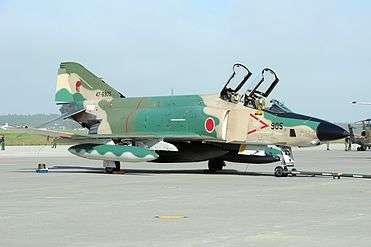
.jpg)
Future aircraft
Projects currently in development are the Mitsubishi X-2, E-2D Advanced Hawkeye, and the Fuji TACOM UAV[13][14]
See also
References
- ↑ "Japan Self-Defense Force | Defending Japan". Defendingjapan.wordpress.com. Retrieved 2014-08-03.
- ↑ "What is JASDF?|ORGANIZATION | [JASDF] Japan Air Self-Defense Force". www.mod.go.jp.
- ↑ Gao, Charlie (19 February 2018). "Japan's Air Force: The Best in Asia?".
- ↑

- ↑ "World Air Forces 2014". Flightglobal.com
- ↑ "First Japanese woman to fly fighter jet". BBC News. 2018-08-24. Retrieved 2018-08-24.
- 1 2 3 4 5 6 7 8 9 10 11 12 13 14 15 16 17 18 19 20 21 22 23 "World Air Forces 2018". Flightglobal Insight. 2018. Retrieved 4 May 2018.
- ↑ "Lockheed Martin unveils first F-35 built for Japan".
- ↑
- ↑ "Japan Receives 1st F-35 Joint Strike Fighter". thediplomat.com. Retrieved 19 March 2017.
- ↑ "Japan searches for new plane for Prime minister". bloomberg.com. Retrieved 3 July 2015.
- ↑ "New government plane delivered to Japan". NHK World. 17 August 2018.
- ↑ "Info" (PDF). www.kosuke.net.
- ↑ "Corporate Profile - Subaru Corporation".
External links
| Wikimedia Commons has media related to Japan Air Self-Defense Force. |
.jpg)
